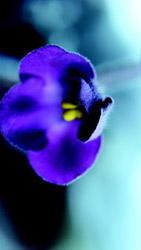
A: The most common reason why African Violets do not bloom is low light intensity. They require good indirect light all year. The light intensity can be reduced by a maturing tree(s), overcast, foggy, or smoggy days. One way to bridge the gap is with ‘Grow Lights’ either, fluorescent tubes or individual flood lights. Ordinary lights do not provide the proper color spectrum to get the plants to bloom. But having said all of that, I do not believe it’s your problem. Vigorous growing plants stop blooming when they are crowded. African Violets like to be transplanted often. Serious hobbyists repot their plants every six-months, while the norm is more like every eighteen to twenty-four months. They do not necessarily have to be transplanted in larger pots. More often they are root pruned and replanted in the same pot with fresh soil added.
Q: Four years ago, we planted a dwarf Blood Orange. The first two years this young tree produced no fruit, then last year it had one orange; however, when we cut it open it was a regular orange color with a slight red color around the edge of the rind. This year the tree has twenty very large oranges. How do we know if the orange flesh will be blood red inside? Is there a special time or way to tell when the fruit is ready?
A: In the Bay Area, Naval, Valencia, Mandarin and Blood Oranges along with Tangerines, can be quite fickle to ripen. While they all turn orange when expected, they’re not necessarily mature, sweet or juicy. Oranges require warm to hot summer days in order to mature on time plus frequent watering. Citrus is watered once to twice a week depending on the temperatures and more often in containers. The milder the summer and the closer to the ocean the longer it takes the fruit to ripen. You shouldn’t be concerned when citrus flowers with last years’ crop still on the plant. ‘Mora’, ‘Sanguinelli’ and ‘Tarocco’ are the three Blood Orange varieties known for their predictable color. The intensity of the coloration seems to vary by light, temperature and variety. The flesh color is the deepest in the hot interior valley. Tarocco matures mid-February to May. The flesh color tends to be unreliable and deeply pigmented. The rind is orange blushed with red at maturity. Sanguinelli ripens in March thru mid-May with an orange flesh streaked with red. Moro’s flesh is a deep red, violet or burgundy and is harvested between February and April. You’ll have to use trial and error to determine when they are ripe. This requires that you pick and taste one. I’m going to guess that the best quality fruit comes later than earlier. Also, it may take many more months hanging on the tree before the crop is ready, so be patient.